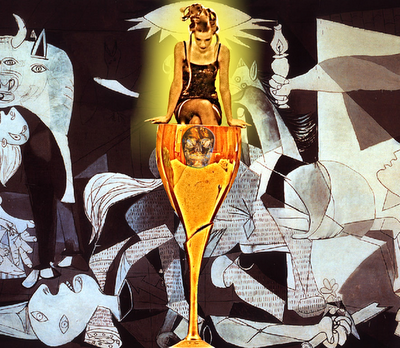Image by Picasso, Thomas Brand and Robert DeFord
(Thank you Thomas)
3 D Guernica
...Picasso's artistic process
Picasso's sketch - composition 1
The first composition for the mural — drawn the very day word of the bombing reached Picasso in Paris — introduced characters that had recurred in the artist's previous work. Picasso shaped and reshaped these figures over the next weeks in a series of preliminary sketches. He brought out the vulnerability of the bull and the agony of the horse. He drew screaming women and children, perhaps inspired by his fear that harm might come to his own baby daughter. He seemed haunted by the many faces of anguish.
"Many of the drawings are much more expressive than the final painting," says art historian Tomas Llorens. "But that is inevitable because Guernica was conceived as a very public image. And some of the meanings and emotions that you can convey on a piece of paper cannot be conveyed in a mural that is seven meters wide. For instance, in one of the drawings there is hair — perhaps the hair of Dora Maar — pasted in a kind of collage. So, you would lose that meaning in a large public mural. But in a sense the energy, the emotional energy that comes from those experiments, is not lost. Picasso was always synthesizing in each image a lot of different possibilities."
On May 11th, just fifteen days after the bombing, Picasso stretched a canvas for the mural. It stood eleven-and-a-half feet tall by almost twenty-six feet wide - so large, he had to brace it at a slant to fit under the ceiling of his studio. He then began to lay out the images in full scale - a woman wailing over her dead child... a warrior clutching a shattered sword as his horse drops in torment to its knees... a jumble of bodies lying trampled on the ground — all part of Picasso's vision of the holocaust at Guernica.
Consequences of War by Rubens
According to art historian, Patricia Failing, "Picasso was very properly trained in the grand tradition of painting, allegorical painting about universal themes: the horrors of war, the massacres of the innocents. Characters that typically appear in these paintings reappear in Picasso's paintings as well. There's usually quite clearly a suffering woman, someone who's screaming, a woman with a child who's been injured, or may even be dead. And to see that Picasso was able to take that traditional academic motif and actually rework it and make it relevant again to this particular time and this particular circumstance, I think is really one of his great achievements in this painting."
With Picasso as he painted was his latest lover, Dora Maar, a young photographer who also became his collaborator. Dora's photographs of the work in progress documented Picasso's creative process and his struggle between political imagery and artistic merit.
Guernica - State I
As the focal point of the painting, Picasso initially drew a boldly raised arm and clenched fist, the familiar salute of the Spanish Republican forces. But the artist was dissatisfied with the obvious symbolism. Over the next several days, he created a more hopeful message of victory, the raised fist clutching stalks of grain in front of a blazing sun. Still, Picasso's artistic sensibility was in conflict with the political sentiment of the canvas. "The stand of Picasso was quite clear," says Llorens. "A work of art, in order to be really effective in political terms, has to work first of all as a work of art."
Pablo Picasso painting
A week later, the arm was completely painted over. But the center of the painting had lost its focus. To solve the problem, Picasso moved the body of the bull near to the woman and child, lifting the head of the horse to a place of prominence and making the spear more obvious. No longer was the battle between the horse and bull of the ring. Clearly, the mortal wound was caused by an act of man.
Picasso's inventiveness took him in many directions. He added color, pattern and texture with scraps of wallpaper; he gave the weeping woman a blood-red tear. Later, Picasso removed all color. Earlier in his career, in his Blue Period, Picasso learned that using a monochromatic palette could produce powerful imagery. He suppressed color because he felt color would distract from the impact of the painting. "There was certainly a long tradition that equated line with intellect and color with emotion," adds Failing. "And so, to not bring in the whole element of color and its associations with emotion and the sensual, in a way makes it a tour-de-force on another level."
Picasso sketch of hand - for Guernica
Picasso then sketched possibilities for the warrior. Not the heroic figure of patriotic fantasy — lifeless, broken, weapons shattered — the warrior in Guernica is no match for the engines of modern warfare. "It's not the clenched fist with the upright arm at the end that becomes such a moving part of the picture, but the outstretched hands with the kind of flayed fingers and the deeply crossed palm," explains Failing.
lightbulb detail from Guernica
As Guernica neared completion, Picasso added a single image of twentieth century technology. According to Llorens: "In Spanish, an electric bulb is called 'bombia,' and 'bombia' is like the diminutive of 'bomb.' So, 'bomba-bombia' is a verbal poetic metaphor for the terrifying power of technology to destroy us."
Shortly after, although he was not at all certain the mural was complete, Picasso delivered Guernica to the Spanish Pavilion.
http://www.pbs.org/treasuresoftheworld/a_nav/guernica_nav/gnav_level_1/2process_guerfrm.html
Sunday, December 21, 2008
Subscribe to:
Posts (Atom)
.png)
